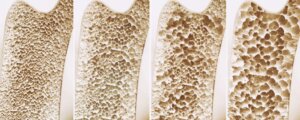Osteoporosis
What is Osteoporosis?
Osteoporosis is a bone disease that occurs when the body loses too much bone, makes too little bone, or both. As a result, bones become weak and may break from a fall.
Osteoporosis is often called a silent disease because one can’t feel bones weakening. Breaking a bone is often the first sign of osteoporosis, alternatively, you may notice that you are getting shorter or that your upper back is curving forward. If you are shrinking in height or your spine is curving, be sure to consult your doctor.
How can I find out if I have Osteoporosis?
If you’re 50 or older and have broken a bone, ask your doctor or healthcare provider about a bone density test, medically referred to a Dual-energy X-ray absorptiometry (DEXA) scan.
To find more information on imaging, check out our X-Ray & Imaging services page.
Osteoporosis means “porous bone.” Viewed under a microscope, healthy bone looks like a honeycomb. When osteoporosis occurs, the holes and spaces in the honeycomb are much larger than in healthy bone (as you can see below). Osteoporotic bones have lost density or mass and contain abnormal structure. As bones become less dense, they weaken and are more likely to break.

How can I Avoid Developing Osteoporosis?
Getting enough calcium and vitamin D is essential to building strong, dense bones when you’re young and to keeping them strong and healthy as you age. Calcium and vitamin D are the two most important nutrients for bone health.
The Importance of Calcium
Calcium is a mineral that is necessary for life. In addition to building bones and keeping them healthy, calcium helps nerves send messages, muscles (including your heart) contract, and with blood clot. About 99 percent of the calcium in our bodies is in our bones and teeth. Each day, we lose calcium through our skin, nails, hair, sweat, urine, and feces, but our bodies cannot produce new calcium. That’s why it is important to try to get calcium from the food we eat. When we don’t get enough calcium, it is taken from our bones which can lead to osteoporosis. The current recommended daily intake of calcium is 1200mg total (a combination of dietary and supplemental sources may be needed) and vitamin D3 1000 IU daily.
Magnesium is also important in forming normal bone architecture and giving your body adequate protein may facilitate faster healing from fractures and improve bone quality.
For more information, consider visiting the Bone Health and Osteoporosis Foundation.
